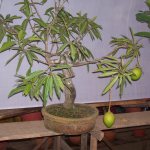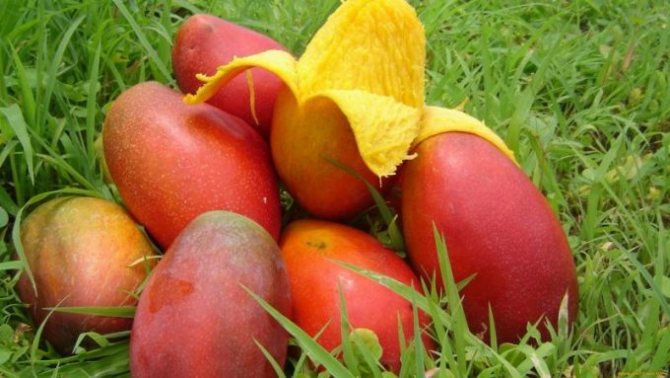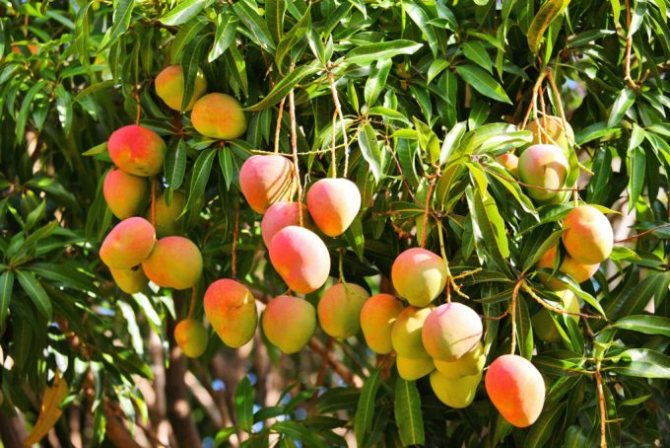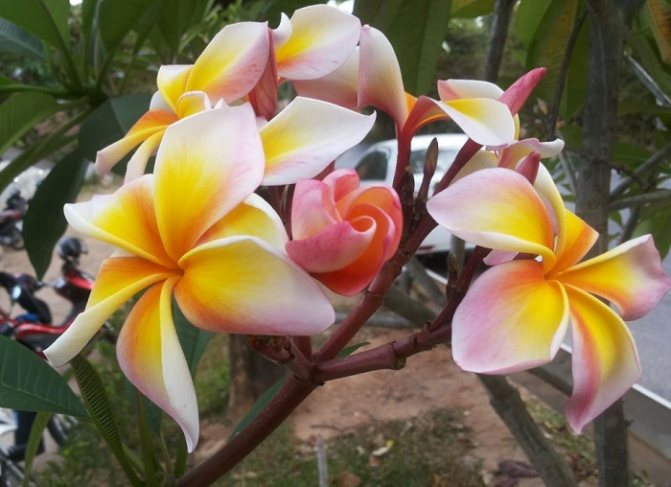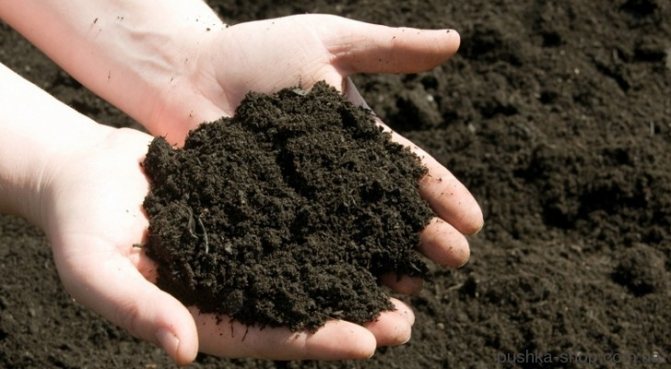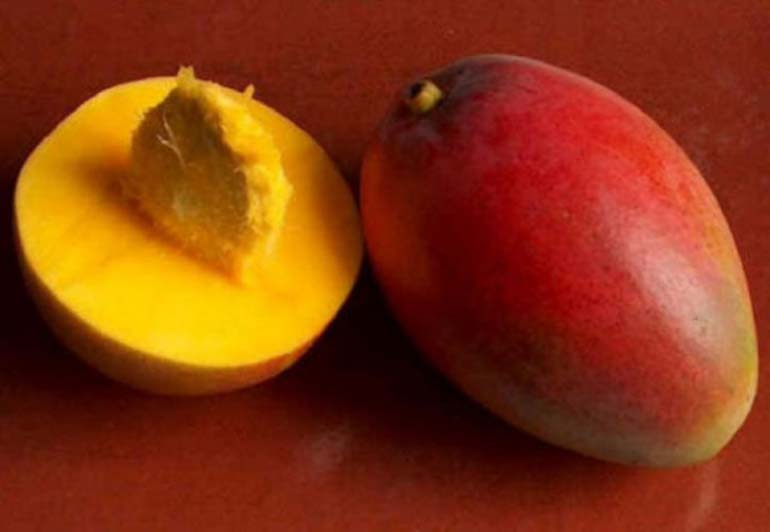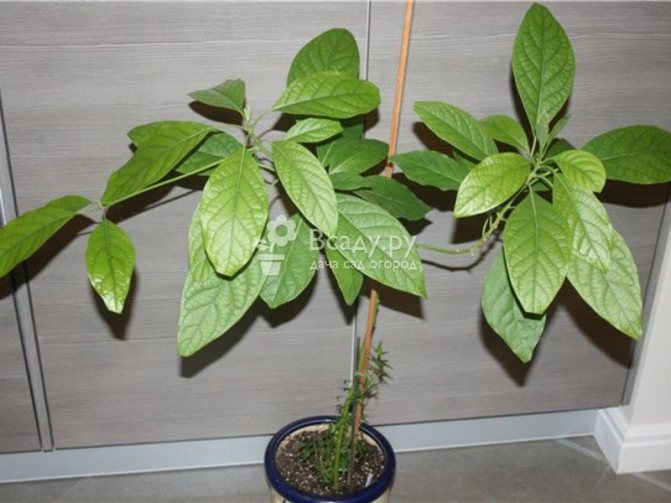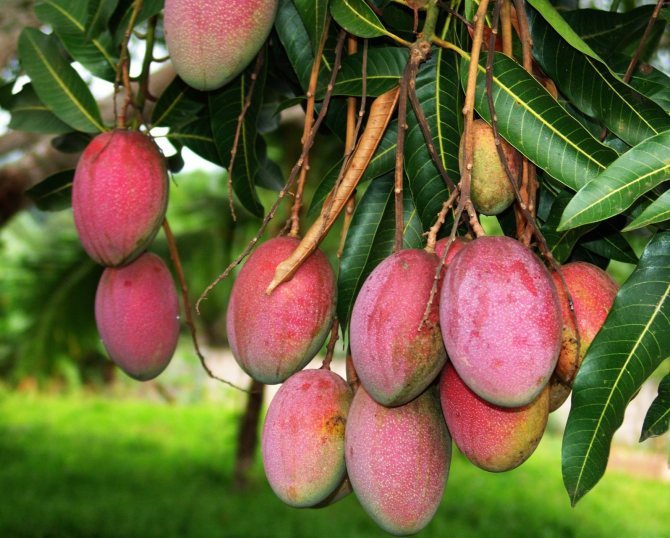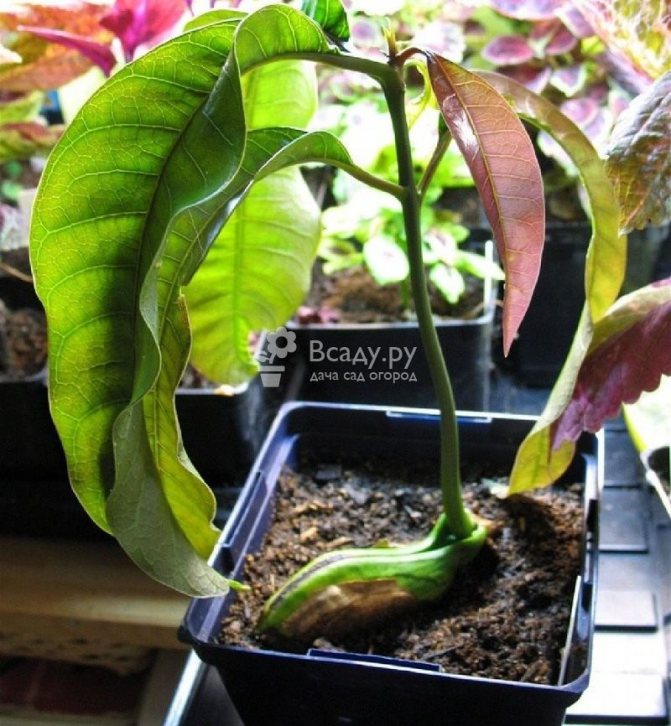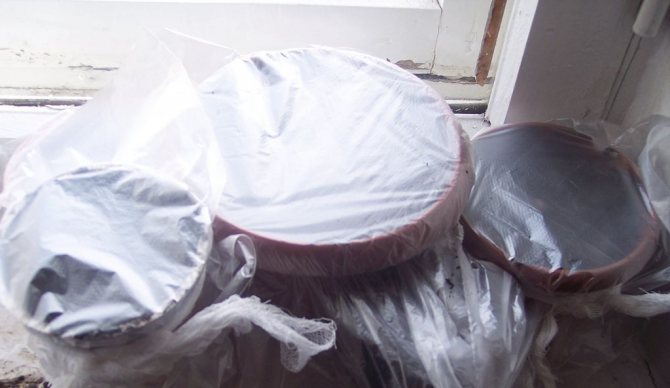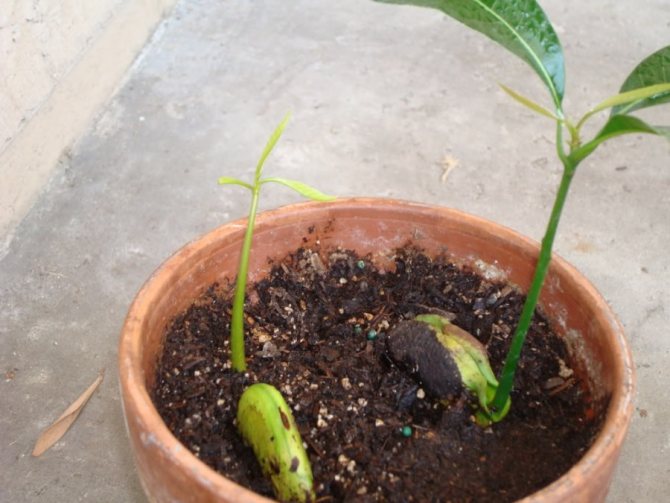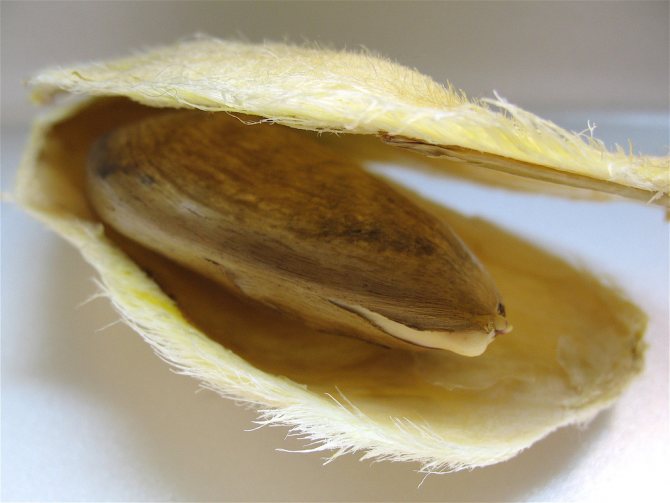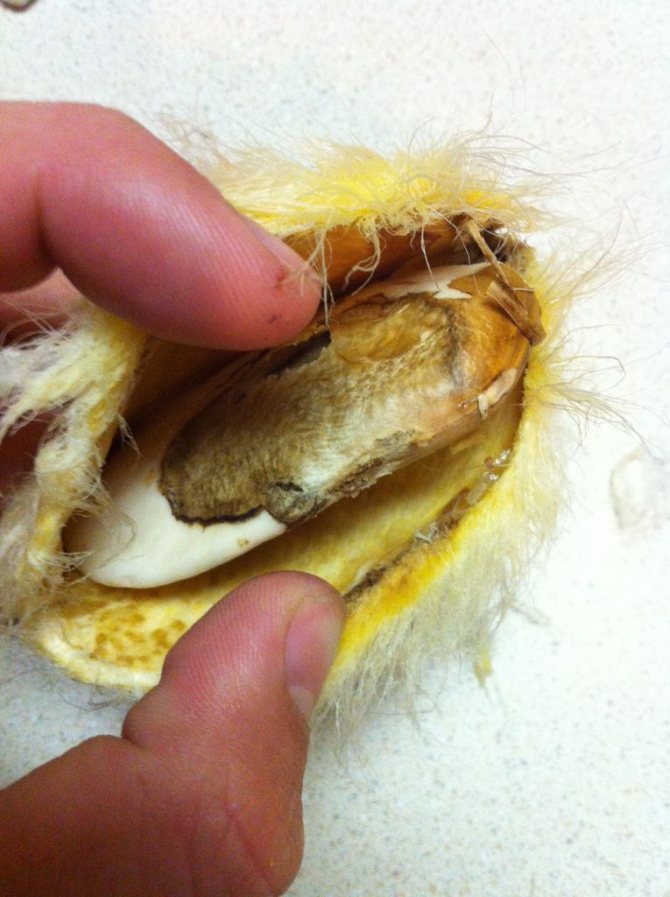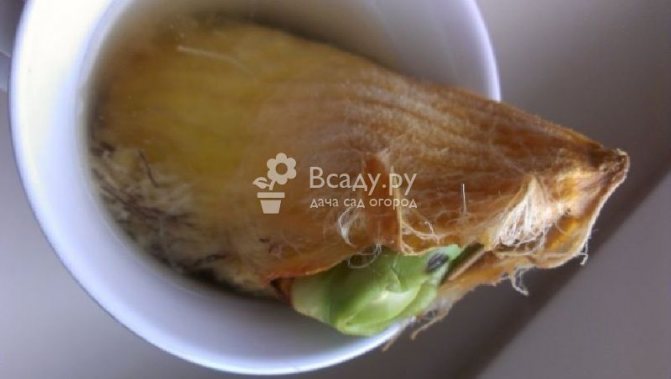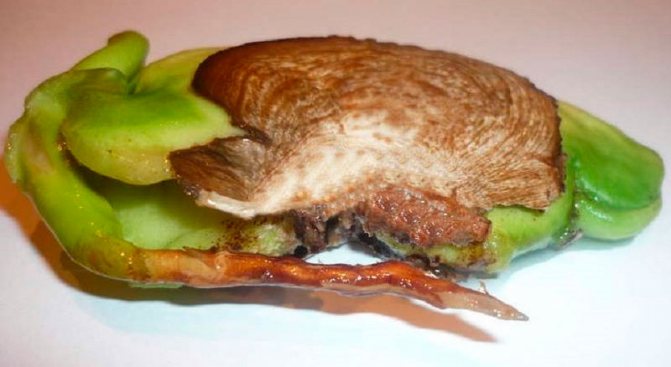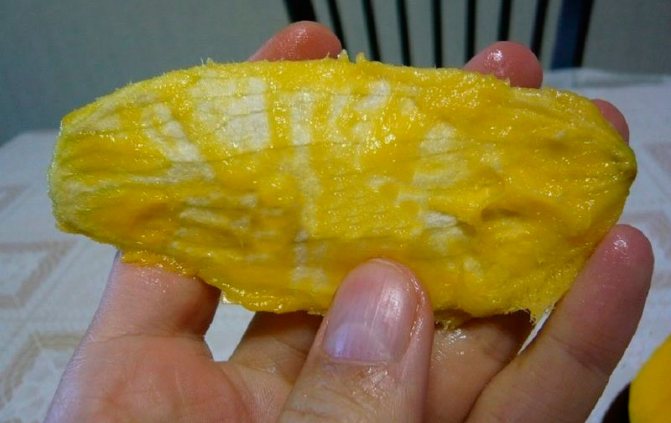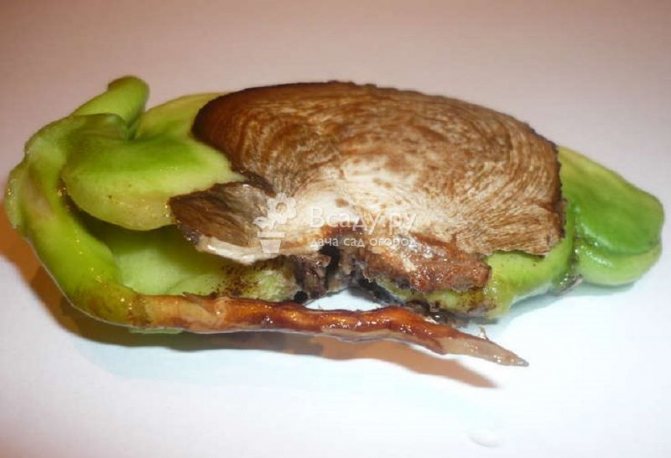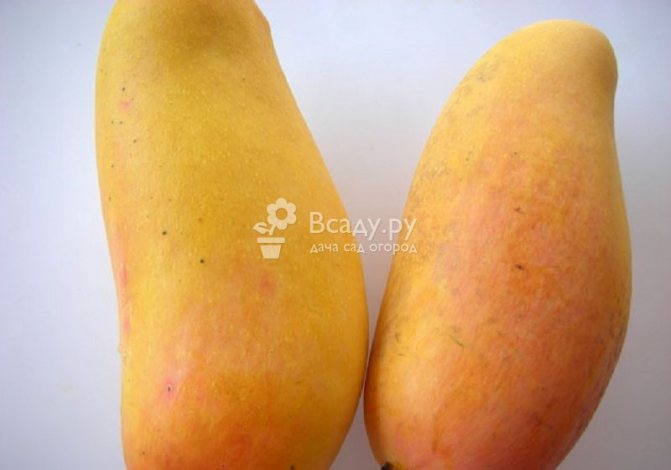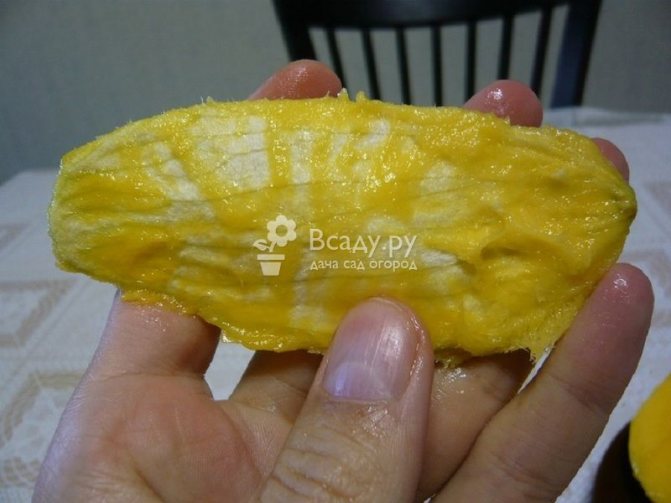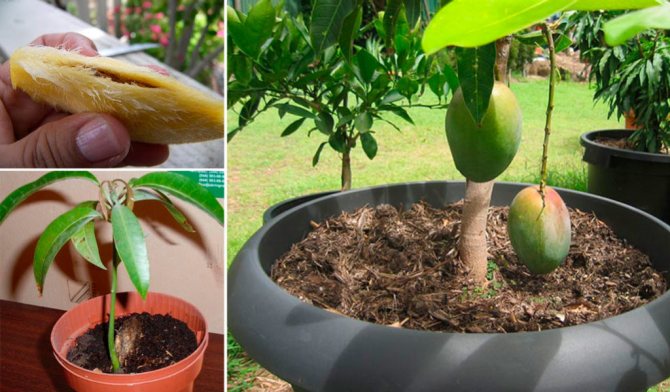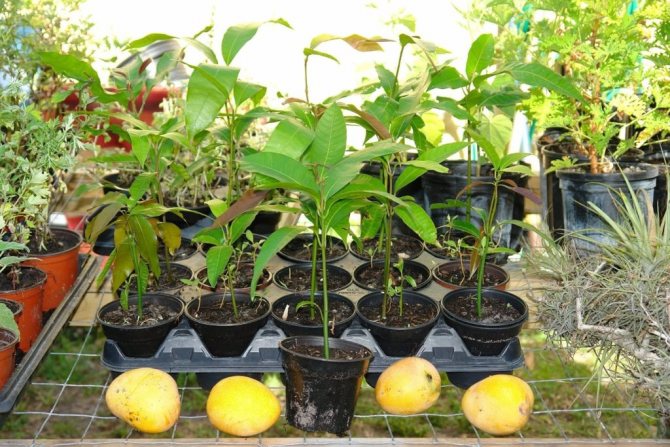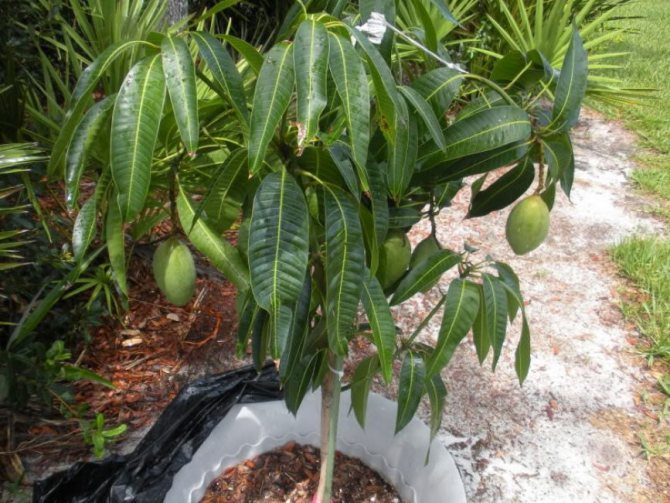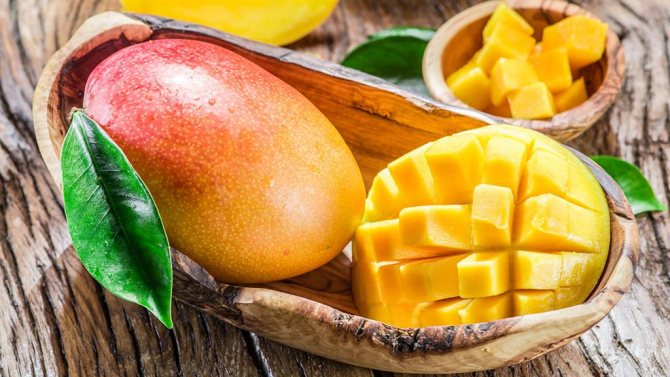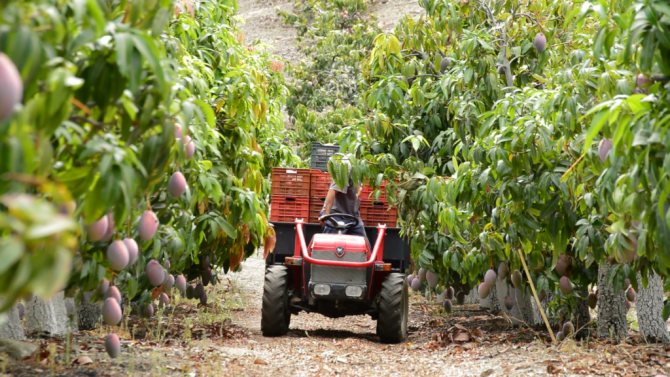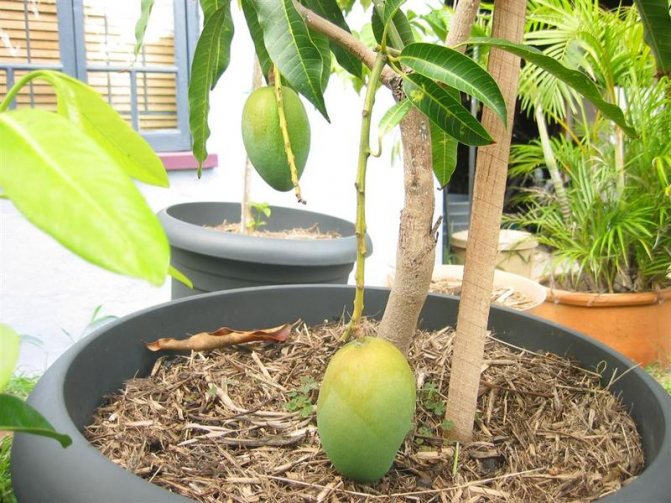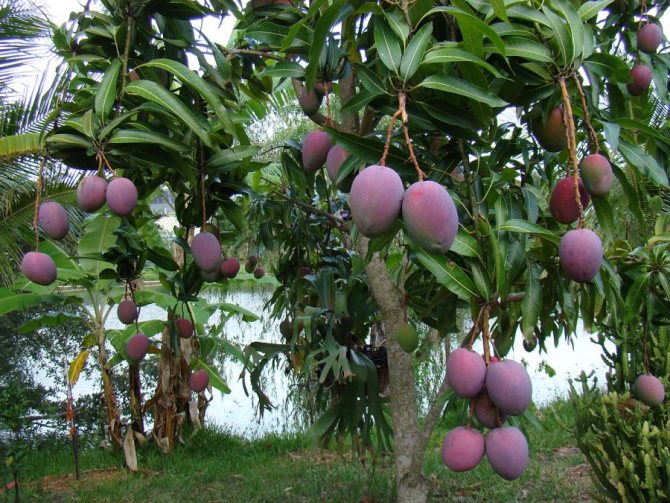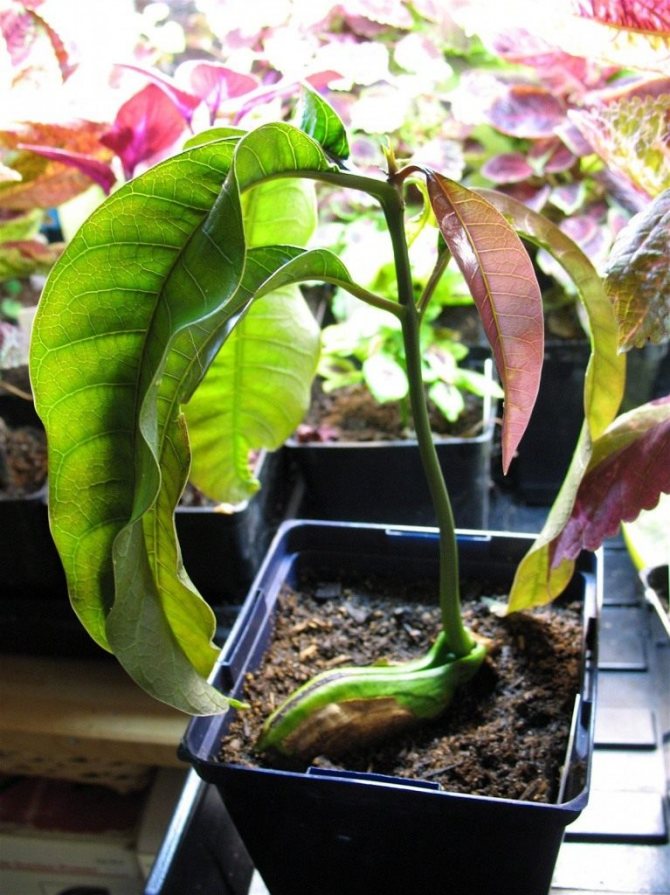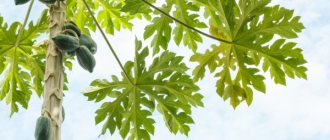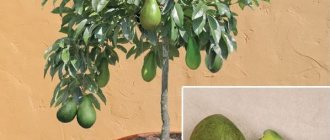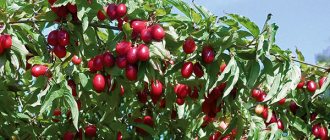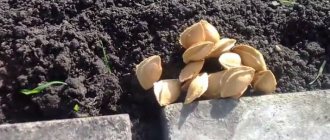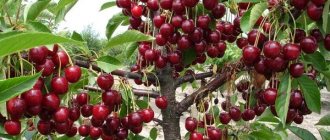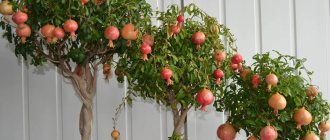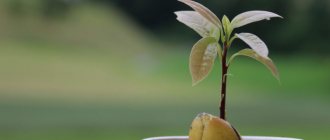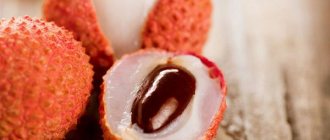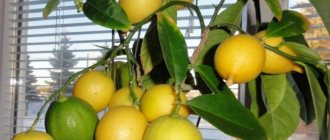Pot selection
Under natural conditions, the mango tree can reach 10-45 meters in height. Plants can initially be planted in a large pot in order to avoid frequent transplants and injury to the root system. The pot must be chosen with drainage holes, on the bottom of which special granules are laid out, which will prevent stagnation of water and rotting of the roots.

You can choose wooden pots for mangoes, as natural materials are great for air permeability. This ability is ideal for mangoes. A plant in a pot with a thick bottom will feel great.
How to choose the right fruit for planting
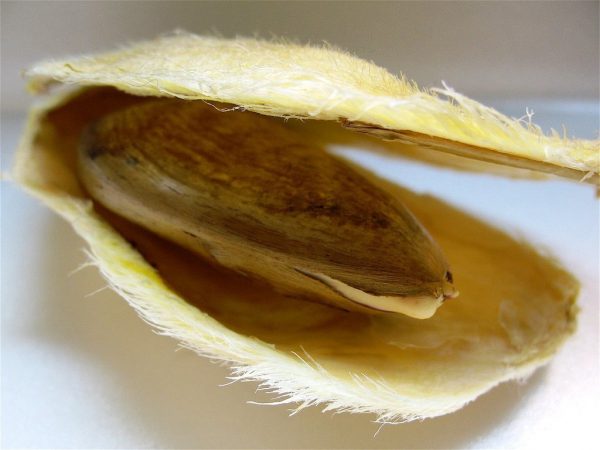

When choosing a fruit in a store for further germination, you should pay attention to its ripeness. Hue in this case does not play the most important role.
Pressing on the fetus will help to make the right choice, it must be sufficiently elastic, hardness or severe deformation is considered bad indicators. Preference should be given to fruits with a whole skin without spots on the surface.
The ripe fruit is characterized by a sweet smell, the aroma of alcohol indicates the beginning of fermentation. When peeling, the pulp should easily separate from the core.
Soil for mango
To make the mango feel comfortable, you can mix the universal soil with sand in a ratio of 2 to 1. Choose a light substrate for planting mangoes. A mixture for succulents with mixed small pebbles or expanded clay is also suitable.
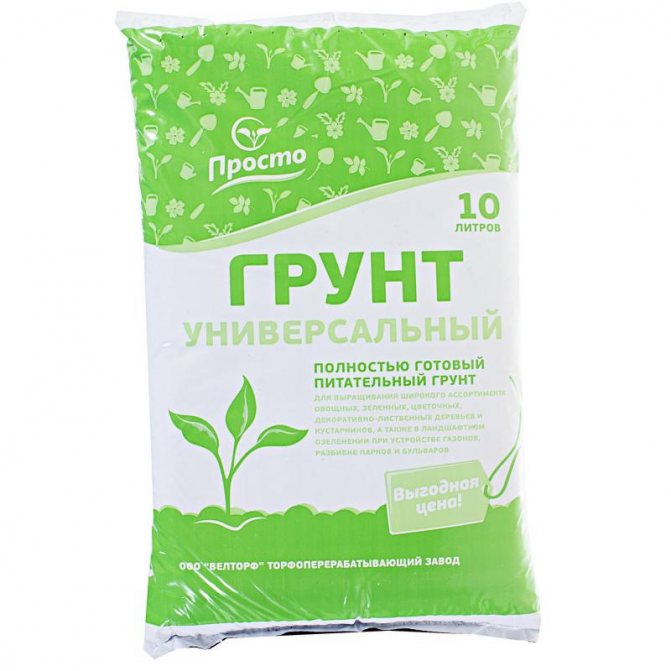

For planting seeds, you can choose a universal type of soil, observing a neutral acidity level. You can check this indicator with a special device with a pH meter or a disposable indicator.
How to grow mango from seed yourself
Nurseries and botanical gardens sell grafted mango seedlings. This method of growing does not require significant effort when planting at home, with a high probability that the tree will have high yields. They mainly buy undersized varieties.
When grown from seed, there is no way to identify a bonsai. The main thing is to choose a seed from a well-ripe fruit. The skin of such a fruit has a red or yellow tint, the pulp is juicy, the stone is separated without effort. Better yet, use an overripe fruit. The nucleus in them sometimes begins to sprout on their own.
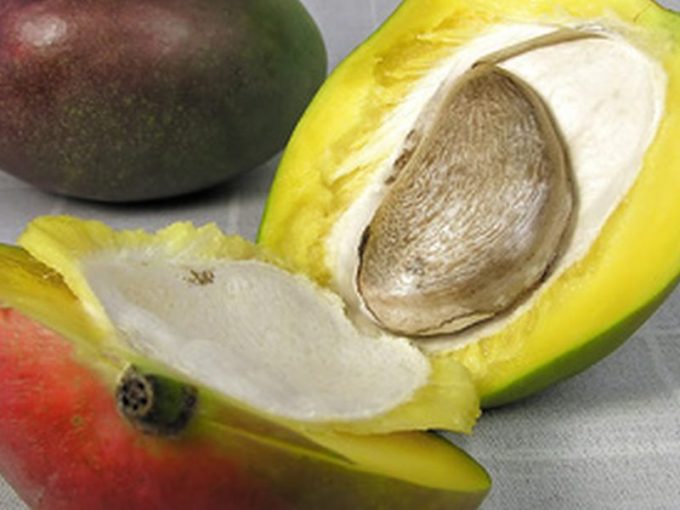

The planting process begins with germination. A tree will not grow from a dried seed. The extracted bone from the fruit is carefully cleaned with a clean knife from the pulp, washed well, placed in a glass dish with warm water. The water is changed daily. When a mango sprout appears, it can be planted in a pot.
You can germinate in another way by wrapping the kernel with a damp cloth. The fabric should be constantly moisturized and kept in a warm place. In some mango varieties, the seed is closed so tightly that water cannot flow inside. The sprout will not hatch and the mango will not grow.
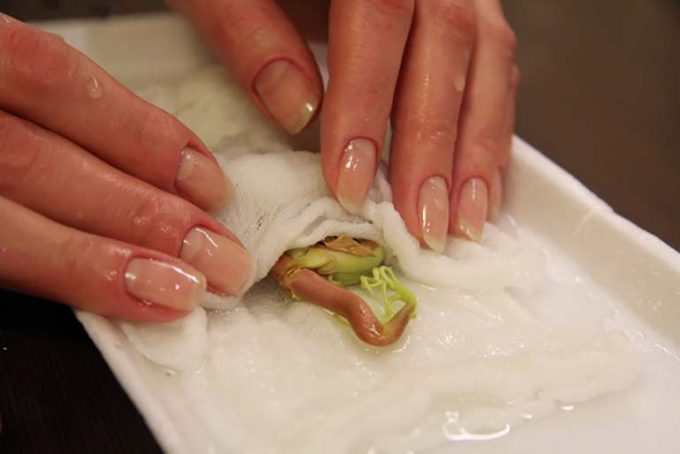

Another way to plant mangoes. Carefully open the shell with a sharpened knife. It is important not to damage the scion on the nucleus. A plastic cup with a lid is prepared in advance. For this method of planting, it is better to buy a ready-made, already disinfected, soil mixture. The glass is filled with soil and the seed is planted in the hole with the sprout up.
Popular: Delicious fruits after grafting of robin apple varieties
Cover the seed completely with soil, water thoroughly and cover with a lid to maintain the microclimate. The cover is periodically removed for ventilation. After two leaves hatch, the lid is removed. The shoot is transplanted into a pot after it gets stronger.
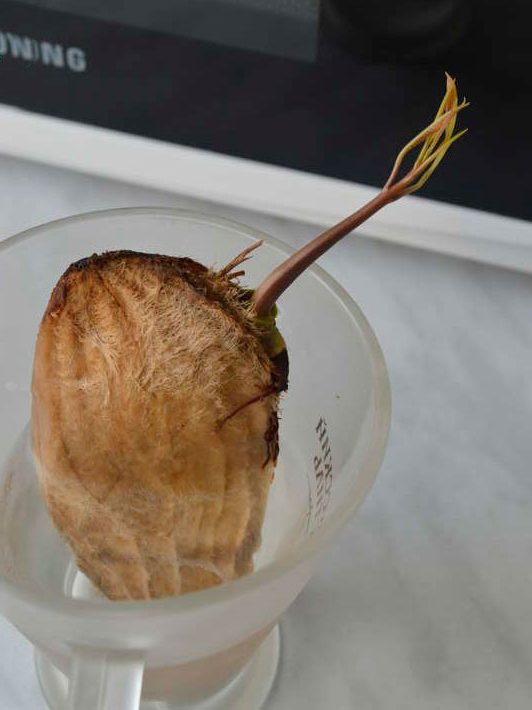

Mango seed planting pots
A pot with a diameter of up to 14 cm is suitable for planting. Small drainage holes are cut in the bottom of the pot. A small layer of expanded clay, pieces of ceramic products, crushed stone, pebbles, brick breakage, small gravel are laid on the bottom. They promote ventilation of the seedling roots and prevent decay.
Planting soil, you can prepare it yourself or buy it at flower shops. The soil is packed and labeled, the soil components and the acidity index are indicated. The seed will germinate well in the soil for succulents or cacti.
You can prepare the soil yourself. Coconut substrate, peat and perlite are mixed in equal proportions. You can also take a mixture of turf and humus soil mixed with sand for germination. In a self-prepared soil, it is necessary to determine the acidity level. In soil with low or high acidity, the plant will begin to ache and disappear. The acidity of the soil is checked with a PH meter. A litmus paper indicator can be used. Litmus changes color upon contact with the ground. When growing mango from stone, loose soil is used (pH 5.5-7.5).
Not all of the seed is horizontally immersed in the soil, leaving a fourth of it on the surface. They moisten the soil well with rain or settled water. When the soil subsides, it is necessary to fill up a small layer. It is advisable to put the pot on the windowsill from the side where there is more sunlight and heat. The planting material in the pot is covered with a transparent plastic container, glass, or cellophane. A greenhouse effect is created in the pot - favorable for further growth. Periodically, the bone is ventilated, raising the shelter. The incoming fresh air will prevent decay.
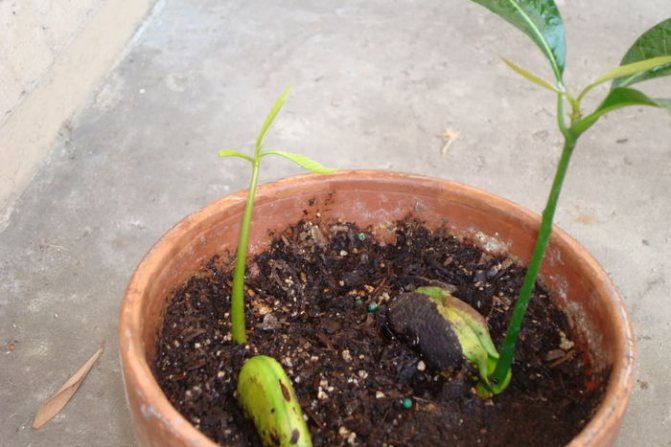

The first sprout appears after a few weeks. After the first two leaves appear on it, the shelter is removed. Proper plant care is a guarantee of healthy growth.
Required temperature
It is possible to grow a mango from a stone at home and turn it into a gorgeous green tree, subject to the temperature regime. Plants do not tolerate sudden changes in the thermometer, which can even kill them. The optimum temperature for the existence of this plant is 22 ° C or more.
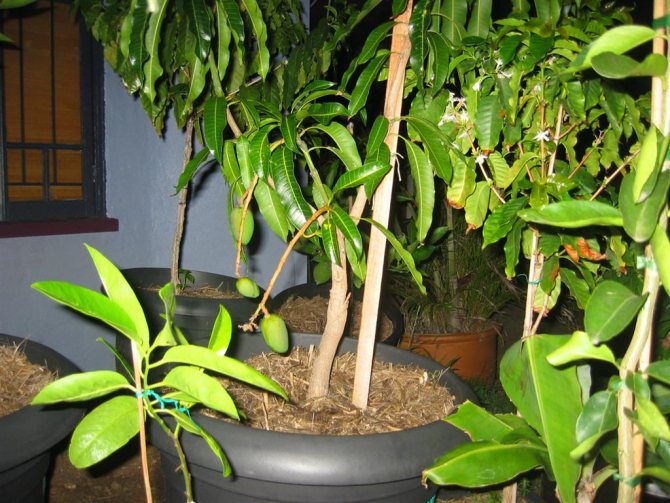

It is necessary to choose not only a warm place for the location of the plant, but also one in which there will be no drafts. Mango does not tolerate wind exposure very well.
Description of the mango tree: how and where it grows
India is considered the homeland of mango, the culture is also found in Asia, in the east of Africa. The culture is sensitive to temperature, dies already at five degrees. The height of the tree reaches 20 m, in nature it gets a spreading crown. The roots go several meters underground, which provides nutrition.
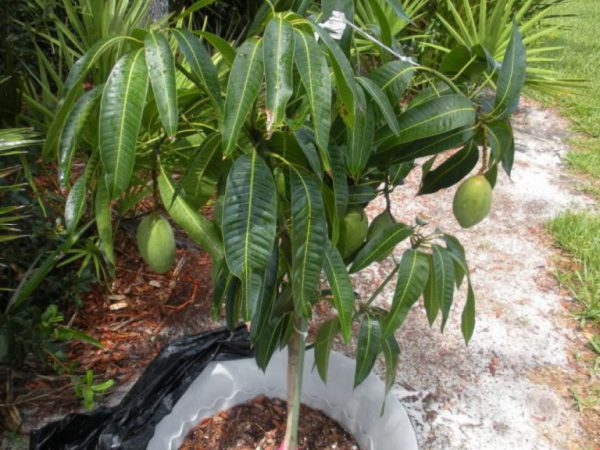

Mango bears fruit for several hundred years, the age of the tree reaches 300 years.
Flowering and fruiting
Flowering is accompanied by the formation of small flowers, fallen panicles are replaced by fruits. The length of the fruit is 5-22 cm, the shape of the mango is very diverse. Weight varies between 250-750 g. The fruit is yellow or green in color, the pulp is orange.
What fruits can you get at home
For planting pineapple and mango at home, dwarf varieties and grafted crops are used. Plants can grow up to 70-150 cm in height. When cultivating grafted species, seedlings grown from seeds are used as a stock.If it is not possible to grow a dwarf variety or a grafted plant, you should limit yourself to regular crown formation. Up to 5 shoots must be left on the tree, the rest are cut off. Due to the intensive growth of the crown, it needs regular trimming, the procedure must be carried out several times a year. Read about the processing of tomato seeds before planting seedlings here.
It is worth noting that even with the observance of the rules of care, regular watering and feeding, it is very difficult to get mango fruits at home. Flowering occurs most often only in the sixth year after planting, the fruits appear only for another three years. In most cases, the only option to get the fruit is considered to be inoculation from the nursery.
Planting mango
There are two planting methods:
- closed;
- open.
Private method
saves time and is distinguished by its simplicity. Includes the following stages:
- Place the pit water.
- Next, a universal soil is prepared, a pot with drainage, and the stage of planting mango begins.
- Soil is poured over the drainage. Those who are not sure which side the mango sprout will start to appear on should lay the pit flat sideways on the ground.
- From above, the bone is sprinkled with earth no more than 2 cm in height, and is abundantly filled with water.
Open method
planting a mango is the need to open the seed.
From the split bone, you need to carefully remove the embryo. If there are several of them inside, you must choose the most developed one.
Conditions of detention
When planting a plant, it is important to observe the conditions for growing and keeping mangoes. The activity of its growth and the process of vital activity depend on this stage.
Mango in nature is found mainly in hot countries where there is high humidity. They respond poorly to all changes in the growing process, stopping growth in height and branching. May start to dry out.
During the cultivation process, you need to maintain a comfortable living environment for the mango tree. It is important to watch out for:
- temperature stability;
- bright light;
- strong humidity.
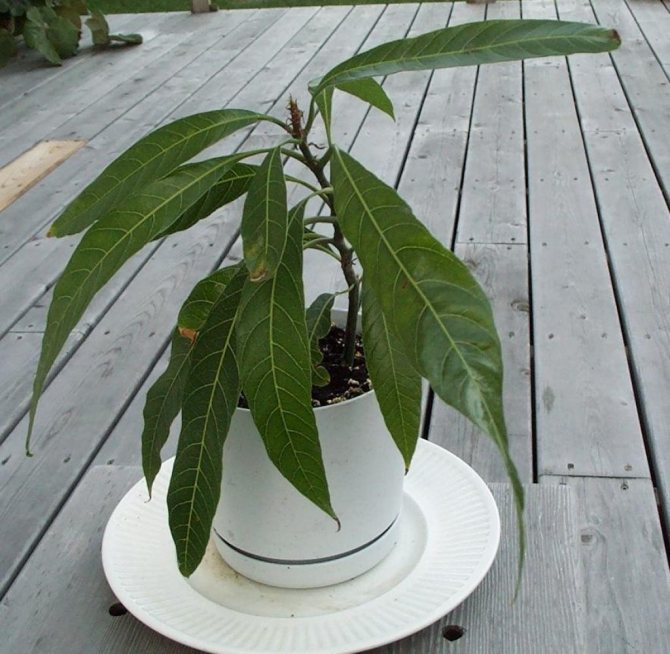

If these growing conditions are met, there will be no problems with a mango tree.
Growing mangoes - temperature and light
Mango prefers a lot of sunlight (up to 10-12 hours a day). Observe several conditions:
- Being on the windowsill. It is preferable to choose windows facing south.
- Using additional lighting. For this purpose, special fluorescent lamps are suitable.
Without enough light, mango growth stops.
Keeping the climate hot for a tree is as important as having the right light. Mango prefers a temperature of +30 degrees. Up to +25 is less suitable, but the plant does not stop growing. It is important that temperature changes do not exceed 5 degrees. Drafts should be avoided.
Place mangoes outdoors in summer. In the evening, when it gets colder, bring back to a warm room.
Humidity
A difficult step in growing a tree is maintaining humidity up to 80%.
The soil needs to be moistened, making it moist, but without an abundance of water. It shouldn't accumulate. The earth must not be allowed to dry out. Better to use settled or filtered water. The temperature is slightly warm.
The moisture balance is maintained by drainage. From February to March, the plant begins to bloom. Frequent watering is contraindicated at this time, but it should not be stopped.
The tree should not be sprayed. This causes mold on the leaves. Instead, follow a different procedure. It consists in monthly washing of the leaves of the plant. Clean the dust carefully so as not to damage them.
Watering
Question:
How to properly water a young plant?
Answer:
Mango trees are very fond of moisture. However, you cannot overdo it with watering.If the plants receive too much liquid, then root decay will begin. Care must be taken to ensure that the soil always remains moist. It is especially important to observe this condition when growing young sprouts and trees up to 5 years old.
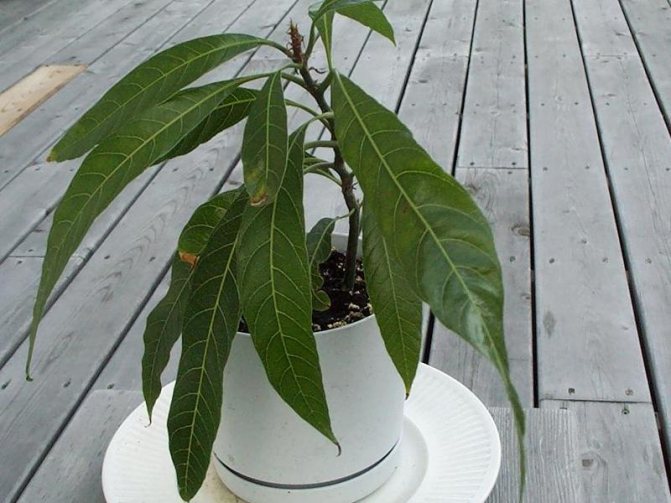

As soon as the plant begins to feel dry, its leaves instantly wither and fall off. This is a sure sign that you need to increase your watering frequency and regularity.
If, after flowering, the fruits begin to knit, then the number of waterings is immediately reduced to a minimum. The mango should be returned to the optimal watering regime only after harvest. On average, you need to water once every 3-5 days. But it depends on the temperature in the room or outside.
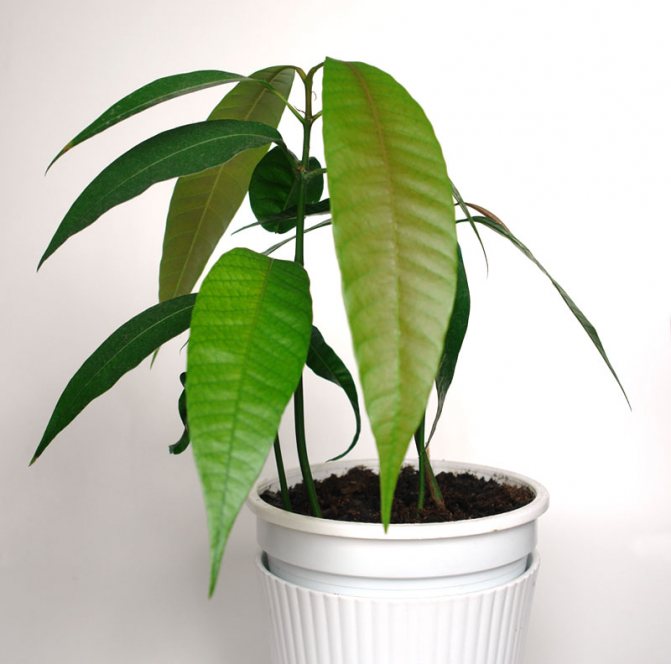

For example, during the summer months, when the heat is intense, mangoes may need to be watered daily. For irrigation, use settled water at room temperature. It is also used for spraying once every 2-3 days.
Mango plant care
Caring for the plant is simple, but it cannot be neglected, since the absence of one or another care measure or its improper implementation can weaken the mango or lead to its death.
Watering
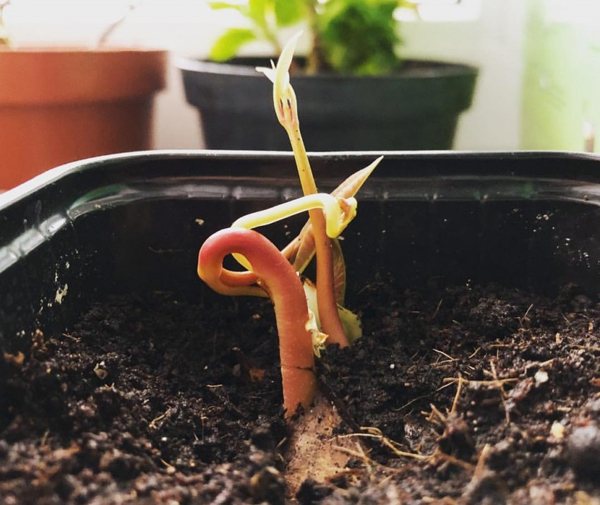

Watering the mango is carried out as soon as the topsoil in the container dries up, about twice a week. In hot weather, watering is carried out daily.
To prevent moisture from evaporating longer, the earth is mulched with humus, rotted sawdust. For moistening, settled water is taken.
In summer, plants are additionally irrigated from a spray bottle. In winter, with dry air, a humidifier or a container with water is installed in the room.
Top dressing
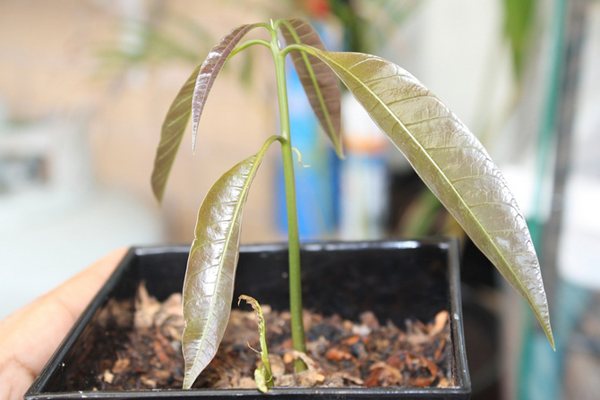

Top dressing of mangoes in the summer is carried out once every 15 days. For this, organic matter, biohumus, nitrogen-containing fertilizers or ready-made dressings for palms or citrus fruits are used.
Once every 2 weeks, the plant is watered with a 2-3% solution of carbamide, ammonium nitrate or ammonium sulfate. Top dressing alternates with Epin, potassium humate and vermicompost.
An infusion of bird droppings, manure, dandelion leaves or nettle is taken as organic matter. It is prepared within 3-5 days. Before use, the infusion is diluted with water in a ratio of 1:10 or 1:15 (if it is droppings). In the middle of autumn, feeding stops.
2-3 times per season, mangifera leaves are sprayed with a solution of boric acid, copper sulfate, zinc sulfate (2 grams of substance per liter of water).
When using organic matter, twice a year, plants are fertilized with humus. For this, a small groove is made along the edge of the pot, humus is poured and ordinary soil is sprinkled on top. This provides the mango with essential nutrients for good growth.
Formation
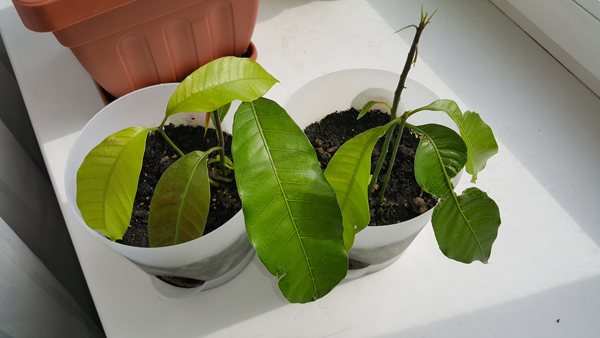

The plant responds well to formative pruning and actively regenerates the crown. Formation is carried out 1-2 times a year to regulate the size of the plant and maintain a beautiful shape. The procedure is carried out when the tree reaches 1.5 meters in height.
When pruning, all branches that thicken the crown are cut out. The central branch is shortened to the desired length. The crown can be formed in the form of a ball, a pyramid, a spreading bush. The pruning sites are processed with garden varnish.
Annually in spring, the top of the plant is pinched, for greater splendor of the crown.
Transfer
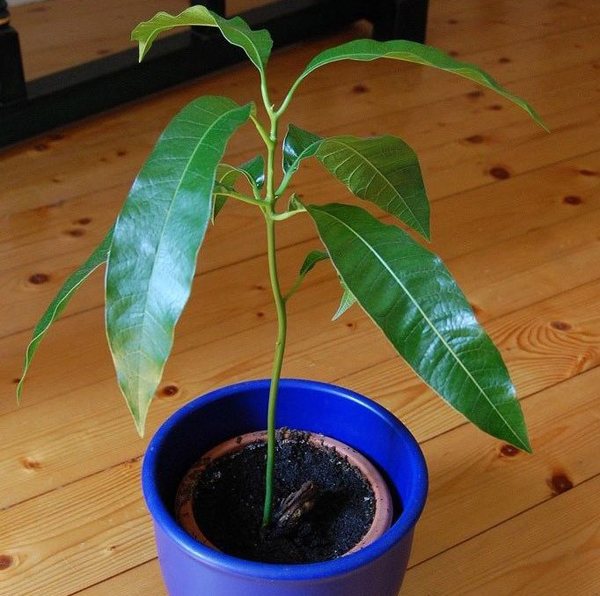

If from the beginning, a small container was taken for planting the mango seed, then with the further transplantation of the plant, you need to wait. The optimal time for this is the period when the plant grows up a little, gets stronger. The final transplantation of a tree into a permanent container is carried out no earlier than 1 year later. If necessary, the tree is transplanted annually, but no more than 1 time during this period.
You should try to avoid frequent transplants, as this is stress for the plant, due to which it can shed leaves or even die.
For transplanting mangoes, take a large, spacious container, drainage and similar soil that was used for the first planting. The plant is removed from the container along with an earthen clod. It is easier to do this if you water it abundantly half an hour before.
The plant is installed in a prepared container with drainage and a thin layer of earth and sprinkled with fresh earth. The planted tree is watered and placed in a darkened place for 3-5 days for adaptation. Then it can be taken out and put in its old, well-lit place.
Diseases and pests of mango
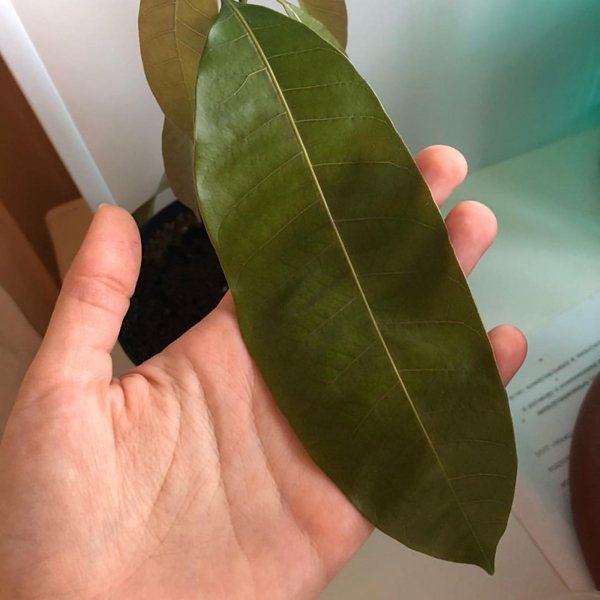

Mango, in case of violation of care measures or in the vicinity of affected plants, can be affected by diseases and pests. Mangifera is treated in the same way as other indoor flowers.
Powdery mildew - a disease that develops with high humidity and sharp temperature fluctuations. When damaged, a white, shapeless coating appears on the leaves. Shoots are deformed, thickened.
For prophylaxis, once every 2-3 weeks, the plant is sprayed with a solution of a biological product (Planriz, Fitosporin-M, Alirin-B) or an infusion of wood ash, a solution of soda ash.
When fighting the disease, the plant is treated with solutions of fungicides, for example, Topsin-M, Topaz, Tiovit-Jet, Fundazol, Bayleton up to 4 times every 7 days.
Bacteriosis - a bacterial disease that penetrates through damage in the leaves or appears with an excess of fertilizer or stagnation of moisture. With the disease, individual sections of leaves and trunks soften and collapse. Dark brown rings appear on the cut of the shoots. The plant begins to rot, an unpleasant odor appears.
To eliminate the problem, the damaged parts of the plant are cut off, capturing 5-7 centimeters of healthy-looking tissue. Sections are disinfected with a 2% solution of copper sulfate. The tree is transplanted into new soil, sprayed with Bordeaux liquid or copper sulfate.
Water for irrigation is replaced for a month with a pale pink solution of potassium permanganate. Alirin-B and Trichodermin granules are added to the soil.
Anthracnose - a fungal disease that spreads through damaged leaves or affected soil. At the same time, brown or yellowish spots appear on the leaves.
To remove the disease, the affected leaves are cut off. The plant is washed with warm water and transplanted into new soil. The tree is treated with a solution of Fitosporin, Kuprozan, Oxychom, Previkura, Skor, Acrobat-MC. Enough 2-3 treatments with an interval of 14-18 days.
As a prophylaxis of the disease, Fitosporin-M, Gamair, Trichodermin are added to the water during irrigation once a month. The soil is dusted with crushed chalk or activated carbon.
Of the pests for mangifera, spider mites, thrips, scale insects and aphids are dangerous.
Spider mite identified by a thin cobweb on the bottom of the leaves. These tiny pests feed on plant sap.
Thrips are small pests that cause great harm to plants. These insects and their larvae, as well as mites, suck the sap of plants.
The methods of dealing with spider mites and thrips are the same. The plant and all surfaces around it are washed with a soap-alcohol solution. The affected areas of the tree are removed. The plant is treated with protective preparations (Akarin, Apollo, Kleschevit, Neoron, Fitoverm, Vertimek). It will take 3-4 treatments, with the replacement of the product. The intervals between treatments are 5-12 days.
Shield feeds on plant sap. In places where pests have settled, brown spots appear over time. When the first signs of damage are found, the pests are removed manually, after having lubricated their shells with kerosene, machine oil, turpentine. Then a shower is arranged for the tree and treatment with Aktellik, Fufanon, Fosbecid.
For prophylaxis, the leaves are wiped once a week with a soft cloth dipped in alcohol or sprayed with an infusion of onions, hot red pepper, and garlic.
Aphid settles on the lower part of the leaves of the plant and multiplies rapidly, forming whole colonies of small pests. They suck the sap of plants and infect it with various diseases.
To prevent infection, the plants are regularly sprayed with soapy water.
Aphids with mango are removed by infusions of any herbs with a pungent smell, for example, wormwood, tansy, tomato and potato tops, calendula, lavender, as well as onions, garlic, lemon peel, tobacco. In the absence of an effect, insecticides Inta-Vir, Tanrek, Mospilan, Iskra-Bio and Konfidor-Maxi are used.
Top dressing for mango
Those who have already understood how to grow a mango need to know that this plant needs to be fed regularly. During the spring and summer, you need to fertilize the soil once a week. In the cold season, feeding once a month is sufficient. The soil is supplied with the following nitrogen-containing and organic fertilizers:
- weed infusion, which is diluted in warm water in a ratio of 1 to 10;
- ash of trees - it is necessary to take an amount at the rate of 200 g per 1 m2;
- compost - you will need the mango in the process of transplanting it. The amount of compost must also be selected at the rate of 1 glass per pot with a volume of 2 liters;
- ammonium nitrate;
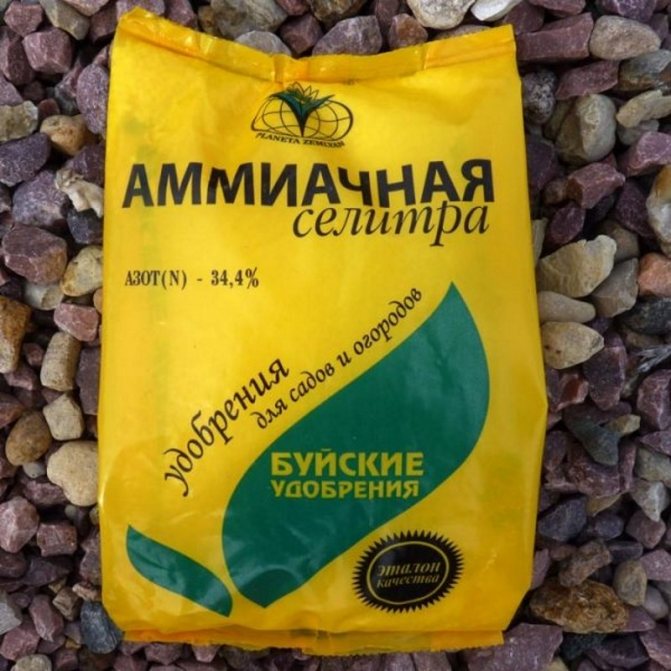

Ammonium nitrate is a purchased fertilizer that has instructions on the package. It is an essential fertilizer for mangoes to promote healthy growth. - sodium nitrate is also added to the soil of the plant according to the instructions on the package;
- urea - an approximate amount per 1 m² about 15-30 g.
Germination
How to germinate a mango seed? Place it in a glass of clean water and do not forget to change the liquid regularly (every two days). You will notice the sprout in about 10 days. This will signal that it is time to plant the mango in the soil.
There is another way - germination in a damp towel (usually gardeners apply this method to melon seeds). The fabric should be regularly moistened with water so that it does not dry out.
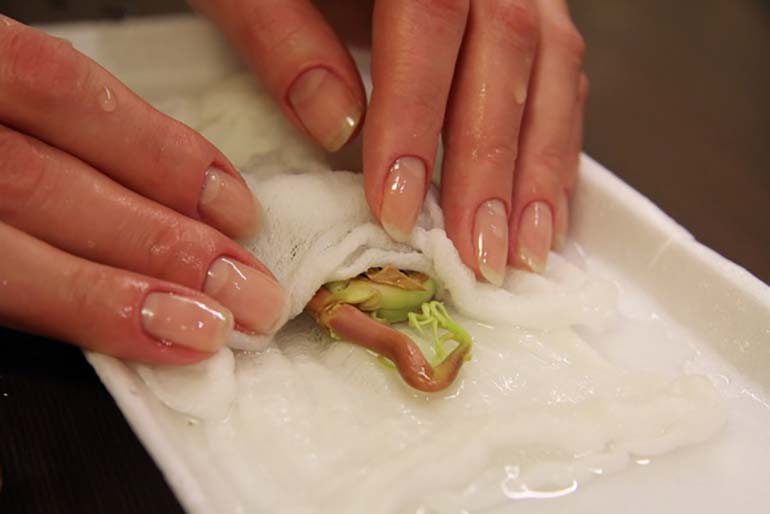

When the seed germinates, it will become clear how to plant the mango seed - its root side should be directed deep into the soil. If there are multiple shoots, they must be divided and planted separately.
Transfer
To grow a mango from a stone at home or to transplant an already grown plant, you need to choose the period of late spring - early summer. There is no need to carry out the transplant process too often. For an adult plant, it will be optimal to perform this procedure once every 3-4 years.
The transplant process itself includes the following stages:
- the mango must be removed from the old pot along with the earth near the rhizome;
- in a new pot, according to the standard scheme, a drainage layer and earth are laid at the level of one third of the total volume;
- the tree is transferred to a new container and covered with soil.
After that, it is necessary for the plant to provide moderate watering and transfer it to a darkened room for about 5 days to protect it from the sun.
How and how to prune a mango
Before pruning, two leaves are selected to see how the healing process goes. The weakest defective leaves on one branch are selected. Determine the location of the cut in the center, leave 5 mm of the leaf on the handle. After some time, the cut cutting will dry out and break off by itself. The tree tolerates pruning well, the structure of the crown improves.
You can form a crown in any style for the interior of the house at the discretion of the owner. Young trees should be pruned as they grow. Pruning of mature trees is carried out after fruiting, when the load on the tree is minimal.
The tree is formed about a meter in height, pinching the growth bud. Rapid growth of crown branches begins - 5-6 main skeletal branches located at a significant angle from the trunk. The branches of the weave and part of the terminal shoots are cut out, since with good care the tree quickly recovers.The crown is brought to the desired shape several times over the year.
Popular: Wide application and planting of breadfruit
In the first two years, when fruit ovaries appear on the tree, they need to be thinned out. In subsequent years, thinning will be superfluous. Mango fruits are voluminous, have a significant weight, so the extra branches will simply break off under the weight. All weak, lateral, low-lying, intersecting branches are removed so as not to restrict the growth of large mangoes.
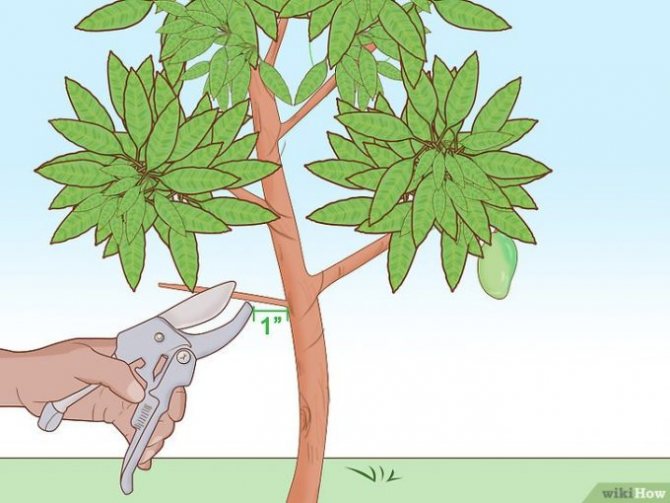

Is it worth grafting mango from a bone
You can grow a mango at home decorative, with beautiful leaves that resemble a palm tree. Such a mango will delight the owner with its appearance. An ungrafted tree will not be able to bloom and bear fruit. It is necessary to plant the plant in the spring, when the movement of the juice is activated. The bud is taken from a fruiting tree. Prepare a sharp, clean knife and carefully cut off the bud along with a piece of wood and bark.
The incision is sealed with garden varnish or painted over. The grafting material is ready. On their tree in the lower part of the T-shaped tree, cut through the bark, bend the corners so as to correctly position the kidney. The kidney is installed, the folded edges of the bark are straightened, the graft is covered with curtains of the bark and isolated. The results of the vaccination will be visible in a month and a half.
The next step will be to cut the branch above the graft. Such a procedure will strengthen, give more vitality to the vaccine. The place of the cut off shoot must be covered with garden pitch. After three years, the tree will bloom, the fruits appear in 3-4 months.
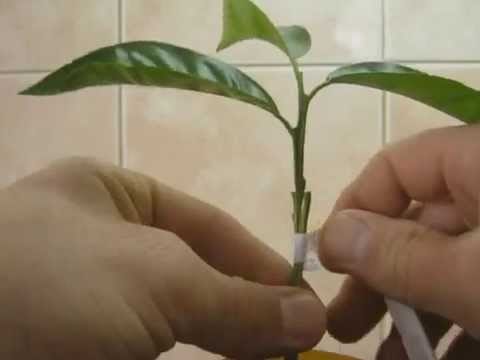

Plant diseases
Like all plants, mangoes are susceptible to disease. Mango is infected with ticks, scale insects, mealybugs, aphids, whiteflies. The tree can be affected by fungal and bacterial infections - powdery mildew, anthracnose, the appearance of bacterial spots on the leaves. In low-humidity air, the tips of the leaves dry out and turn brown. From the cold, mango flowers fall off.
Examples of mangoes with photos
Fruit in nature
Mango is an evergreen tropical tree with valuable, tasty and nutritious fruits... His homeland is East India. Gradually, it moved to other Asian countries, East Africa, California, Spain, and the Canary Islands.
The mango is a long-lived tree. In nature, there are trees that are up to 300 years old and they still bear fruit. In natural conditions, mango grows to about 20 meters in height or more. In young trees, the leaves are yellow-green, while in adults they gradually darken and become more saturated, dark, large and reach a length of about 20 cm.
Mango blooms in February, March. Inflorescences reach up to 40 cm in length. The scent of flowers is similar to the scent of lilies. fruit weight from 250 grams to 2 kilograms. Fruits ripen for about 3 months, and especially large ones for about six months. All this time, the fruits hang on long sturdy stems left over from the inflorescences, which looks very unusual.
The ripe fruit has a smooth, thin skin of a greenish-yellow hue with a bright red spot on the side facing the sun. The orange pulp of the fruit simultaneously tastes like peach and pineapple, very juicy and tender.
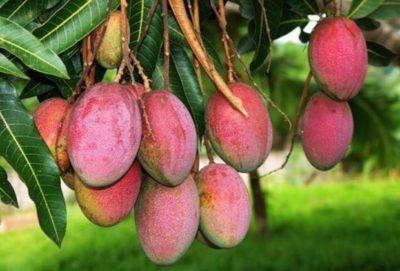

Propagated by mango by sowing seeds, vegetatively and grafting... Due to the rapid loss of germination, it is better to sow seeds immediately into the ground after being removed from the fruit.
The vegetative method is not so popular due to its laboriousness and inefficiency. Even when treated with stimulants, cuttings do not take root well. But even established plants poorly develop the root system, which is not enough for the normal growth and development of the plant.
In industrial nurseries, mangoes are propagated by grafting. This preserves the genetic properties of the selected variety, preserves the crown habit, fruit properties and other traits.
Video about the features of growing mango
In this video, you can see the initial stages of growing a mango tree from a bone:
How to properly prepare the bone for planting in the ground, you can learn from this video:
The mango tree is a unique exotic tree that, with its beautiful appearance, can complement any collection of a florist. Subject to the rules of planting and care, such an unusual green plant can produce delicious and juicy fruits. The main thing is to properly plant the sprout after planting the mango, and provide it with high-quality regular fertilizing.
How to achieve fruiting mango at home
When growing a decorative mango tree at home, flowering and fruiting does not occur by itself. Providing favorable conditions, you can get an ornamental tropical plant, characterized by high aesthetic appeal. The dwarf variety is adapted to domestic conditions. It is much easier to get a delicious fruit from such specimens.
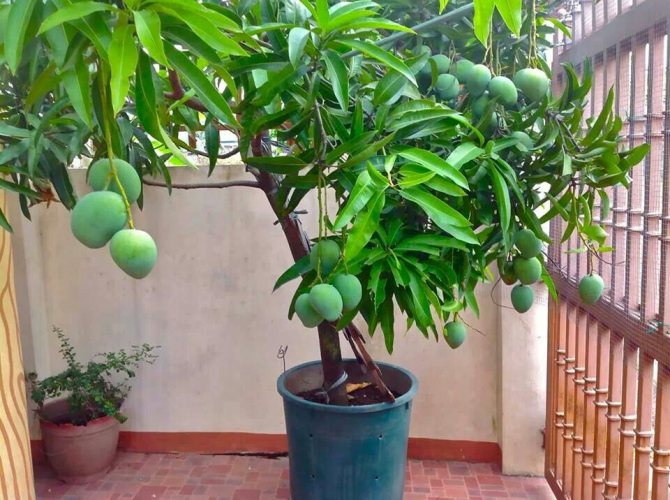

Mango fruit on tree
Mango blooming is a delightful sight, but remember that only grafted individuals can bloom and bear juicy fruits. You can graft a plant grown from a seed by yourself using the budding method. To do this, you need a bud from a fruiting tree.
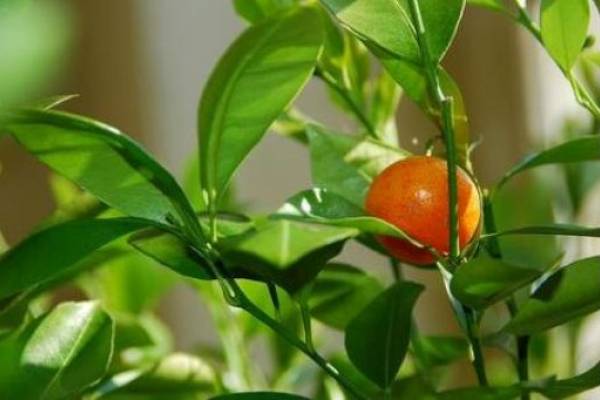

You may be interested in:
How to grow persimmon from a stone? Before starting to grow persimmons on your own, you should learn as many subtleties as possible that are worth ... Read more ...
It is recommended to carry out such a procedure according to the following scheme:
- with a sharp, sterile knife, cut off the bud with a piece of the bark of a fertile tree;
- make a T-shaped incision on the house plant;
- gently bend the bark and plant the cut kidney there;
- fix the connection with soft insulating tape until the kidney grows.
After such a procedure, it is recommended to regularly fertilize the mango using nitrogen fertilizers. A plant grafted in this way blooms in about two years. After that, three months later, the first crop will appear.

